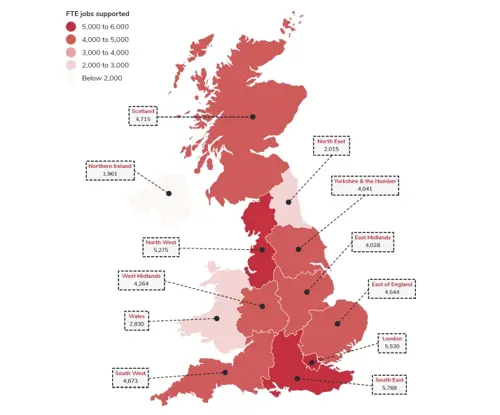4.1. Driving footfall to our high streets
As well as its direct contribution to the economies of local communities (outlined in Section 5), Post Office also has a wider, indirect role in catalysing local economic activity and so acting as an anchor for high streets.
Some tasks simply cannot be completed online – from dropping off a return to depositing cash – necessitating a trip to the local high street. When individuals visit their local post office to access its wide range of essential services, they often go to shop elsewhere in the nearby area, whether buying a chocolate bar or picking up a coffee. In fact, this research indicates that, for every two in five visits to a post office, money is spent elsewhere in neighbouring shops and premises. This footfall-driving effect, in turn, results in wider spending and generates an impact in addition to Post Office’s direct expenditure, by acting as an engine for local economies.
The estimated overall spending nearby during visits to post office branches amounts to as much as £3.1 billion a year (not including in retail outlets of post office branches).¹⁵ This figure was calculated by multiplying the average spend elsewhere on the high street when making a visit to a local post office (£14.55) by the likelihood of making purchases elsewhere on a post office visit (43%), and then by the number of post office visits 16 per year (approximately 500 million).
A proportion of this expenditure will be ‘additional’, in the sense that it would not have otherwise been made if somebody had not made a post office visit. For example, somebody visiting their local post office may go into a local retailer and make a purchase that they otherwise would not have made. Others will shop on their local high street and spend money that would otherwise have been spent elsewhere if a visit to their local post office had not been made. For example, somebody visiting the supermarket while visiting their local post office would probably have shopped at a different supermarket and therefore the total level of expenditure would remain the same. However, even if much of the expenditure is not strictly ‘additional’, there are two distinct benefits.
- Firstly, visits to Post Office branches attract visitors to the high street rather than online or
to out-of-town locations, meaning Post Office generates income for these local businesses (which are more likely to be smaller and independent compared to the alternatives), contributing to the preservation of the United Kingdom’s high streets. This additional expenditure that sustains local businesses on the high street further strengthens local communities, in turn contributing to the ‘unseen’ social value of Post Office (which is explored in more detail in Section 5).
- Secondly, it provides greater convenience for consumers, by allowing them to do a greater proportion of their shopping in one place (which is also explored further in Section 5). This feature is particularly valued by older people (55+) and those in rural areas, which is evidenced by them being more likely to spend money elsewhere on a Post Office visit than younger people and those living in
urban areas.
Visits to Post Office branches help generate additional spending for local businesses across the whole of the United Kingdom, as illustrated in Figure 4 – once again highlighting the breadth and range of Post Office’s economic value to the country. However, Post Office’s role in driving wider high-street spending is a particularly strong outside England, with Northern Ireland and Wales having the greatest expenditure elsewhere per person (£59) in 2021- 22. There are also particularly strong impacts in the North East (£52), Yorkshire and the Humber (£51) and the North West (£50). The strong impacts in Northern Ireland, Wales, North East England and Yorkshire and the Humber are particularly significant, given that those were the four regions with the lowest regional gross domestic product per capita in the United Kingdom in 2020 (Office for National Statistics, 2022e). This wide-ranging impact highlights the influence that Post Office has throughout the country in encouraging local growth and tackling regional disparities, while acting as an anchor for high streets.
Figure 4
Expenditure elsewhere on a Post Office visit in each United Kingdom region, per person and overall, 2021-22
Note: Total expenditure elsewhere on a Post Office visit by region was divided by mid-2020 population estimates for UK regions (Office for National Statistics, 2021b) to obtain per person figures. Considers all individuals in the UK, not just Post Office visitors. Includes additional expenditure elsewhere but does not consider additional expenditure in Post Office retail outlets.
Source: London Economics’ analysis based on Post Office data, YouGov’s consumer survey and Office for National Statistics (2021b). Contains National Statistics data, OS data, Royal Mail, Gridlink, LPS (Northern Ireland), ONS, NISRA data, NRS data and Ordnance Survey data © Crown copyright and database right 2022.